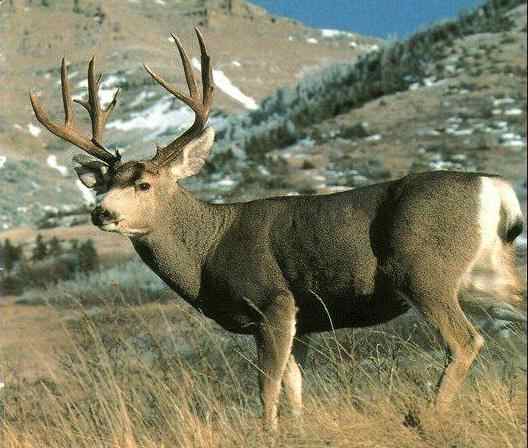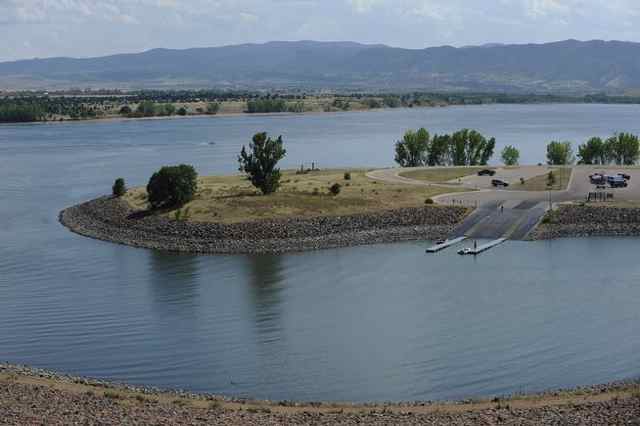Long Range Fish Report
From Sportfishing
From Sportfishing
Fish Report for 12-9-2013

CRITICAL COLORADO WILDLIFE PROJECTS KEEP CPW PERSONNEL BUSY OVER WINTER
12-9-2013
Colorado Parks & Wildlife
DENVER - Although the main big game hunting seasons have ended, Colorado Parks and Wildlife's researchers and biologists are preparing for another busy time of the year. Beginning in early December through late March, CPW employees will climb aboard aircraft and fly across large swaths of wildlife habitat in search of big game animals to classify by sex and age while others will gather biological data on the ground. Late-season hunters and outdoor recreationists are advised that they may see low-flying helicopters or airplanes and are urged to be patient while critical monitoring is conducted.
In addition to a thorough inventory of thousands of animals, CPW staff will coordinate the helicopter capture and radio-collaring of 75 elk, 90 moose, 20 desert bighorn sheep, 25 Rocky Mountain bighorn sheep and 1,300 mule deer, including 800 does, 400 fawns and 100 bucks. With the data collected, agency researchers and biologists will be able to track the progress of several wildlife management efforts and ongoing studies. They will also gain a clearer picture about the overall health of big game, allowing wildlife managers to form population models, management strategies and set future hunting license numbers.
"We will spend long hours in cold temperatures and harsh conditions, but it is vital that we keep track of how all these species are faring across the state," said Northwest Region Senior Terrestrial Biologist Brad Petch. "These yearly efforts provide us with vitally important information that helps us effectively conserve Colorado's populations of big game animals."
Radio-collared animals provide a variety of biological information. For example, tracking collared bighorn sheep survival, movements and populations following a large wildfire can provide information that may predict the impacts to the animals after future fires. Studying collared mule deer allows biologists to closely monitor varying survival rates of adults and fawns, useful for estimating population sizes and improving management techniques.
CPW mammals researcher Chuck Anderson is leading a ten-year study to measure how Piceance Basin mule deer populations have responded to natural gas exploration. He is also studying the efficacy of mitigation efforts designed to address human activity and habitat degradation in the resource rich area.
"We have been concerned about the steady decline of mule deer populations in several areas of Northwest Colorado and we need as much information as we can get to reverse the trend," said Anderson. "Capture and collar operations are among the most important methods we use to gather data about mule deer migration patterns and movements in response to human activity."
The Piceance Basin research project began in 2008 and is scheduled to continue until 2018. It is funded primarily by several energy producers currently exploring in the area.
"Whether you are a hunter, outfitter, local business, energy producer or a member of the general public, we all have a vested interest in finding effective solutions that will allow the continued exploration for much needed energy while maintaining and preserving the viability of this critical mule deer habitat," added Anderson. "This research project will be instrumental in helping us find solutions to this challenging issue."
One of the preferred methods researchers use to capture ungulates is 'net-gunning' which involves the use of a net launched from above by skilled helicopter crews that safely and effectively immobilizes an animal. Biological data can be gathered and the animal can be fitted with a GPS or radio collar at the capture site, allowing for its release in a matter of minutes. Alternatively, it can be carefully lifted and delivered to a nearby base camp where a contingent of researchers, veterinarians and volunteers gather blood samples and record body condition, weight, age and sex. A collar is then placed on the animal before it is released.
"Net-gunning is far less stressful to the animal than immobilizing drugs," said Petch."It is challenging work, especially for the helicopter crews, but it allows us to gather vital information efficiently with the added benefit of significantly reducing inadvertent mortality."
Big game coordinator Andy Holland adds that capture operations using aircraft results in a wider distribution of collared animals than is possible from ground captures alone.
"From the air, we can capture in remote and rugged areas by avoiding physical barriers like deep snow and cliffs," said Holland. "This enables us to rapidly capture a wider cross-section of the overall population, improving the value of the information we gain from each collared animal."
Holland says that in addition to reduced costs, the use of helicopters helps researchers meet their capture goals before the harshest part of winter sets in. This allows for the accounting of natural mortality of collared animals that occurs during that time.
"Our goal is to safely and quickly capture a representative number of these animals," said Holland. "The public should know that we work hard to be efficient while keeping the animal's stress to a minimum."
Colorado Parks and Wildlife reminds the public that although a few of the aerial operations may inconvenience some hunters today, the long-term benefits, including healthy wildlife populations and productive hunts in the future, should be considered.
"Colorado has an extremely valuable natural resource that we are working hard to conserve," said Petch. "We appreciate everyone's contributions and patience as we continue to find ways to ensure the health of our wildlife in the face of a growing human population and other challenges."
In addition to a thorough inventory of thousands of animals, CPW staff will coordinate the helicopter capture and radio-collaring of 75 elk, 90 moose, 20 desert bighorn sheep, 25 Rocky Mountain bighorn sheep and 1,300 mule deer, including 800 does, 400 fawns and 100 bucks. With the data collected, agency researchers and biologists will be able to track the progress of several wildlife management efforts and ongoing studies. They will also gain a clearer picture about the overall health of big game, allowing wildlife managers to form population models, management strategies and set future hunting license numbers.
"We will spend long hours in cold temperatures and harsh conditions, but it is vital that we keep track of how all these species are faring across the state," said Northwest Region Senior Terrestrial Biologist Brad Petch. "These yearly efforts provide us with vitally important information that helps us effectively conserve Colorado's populations of big game animals."
Radio-collared animals provide a variety of biological information. For example, tracking collared bighorn sheep survival, movements and populations following a large wildfire can provide information that may predict the impacts to the animals after future fires. Studying collared mule deer allows biologists to closely monitor varying survival rates of adults and fawns, useful for estimating population sizes and improving management techniques.
CPW mammals researcher Chuck Anderson is leading a ten-year study to measure how Piceance Basin mule deer populations have responded to natural gas exploration. He is also studying the efficacy of mitigation efforts designed to address human activity and habitat degradation in the resource rich area.
"We have been concerned about the steady decline of mule deer populations in several areas of Northwest Colorado and we need as much information as we can get to reverse the trend," said Anderson. "Capture and collar operations are among the most important methods we use to gather data about mule deer migration patterns and movements in response to human activity."
The Piceance Basin research project began in 2008 and is scheduled to continue until 2018. It is funded primarily by several energy producers currently exploring in the area.
"Whether you are a hunter, outfitter, local business, energy producer or a member of the general public, we all have a vested interest in finding effective solutions that will allow the continued exploration for much needed energy while maintaining and preserving the viability of this critical mule deer habitat," added Anderson. "This research project will be instrumental in helping us find solutions to this challenging issue."
One of the preferred methods researchers use to capture ungulates is 'net-gunning' which involves the use of a net launched from above by skilled helicopter crews that safely and effectively immobilizes an animal. Biological data can be gathered and the animal can be fitted with a GPS or radio collar at the capture site, allowing for its release in a matter of minutes. Alternatively, it can be carefully lifted and delivered to a nearby base camp where a contingent of researchers, veterinarians and volunteers gather blood samples and record body condition, weight, age and sex. A collar is then placed on the animal before it is released.
"Net-gunning is far less stressful to the animal than immobilizing drugs," said Petch."It is challenging work, especially for the helicopter crews, but it allows us to gather vital information efficiently with the added benefit of significantly reducing inadvertent mortality."
Big game coordinator Andy Holland adds that capture operations using aircraft results in a wider distribution of collared animals than is possible from ground captures alone.
"From the air, we can capture in remote and rugged areas by avoiding physical barriers like deep snow and cliffs," said Holland. "This enables us to rapidly capture a wider cross-section of the overall population, improving the value of the information we gain from each collared animal."
Holland says that in addition to reduced costs, the use of helicopters helps researchers meet their capture goals before the harshest part of winter sets in. This allows for the accounting of natural mortality of collared animals that occurs during that time.
"Our goal is to safely and quickly capture a representative number of these animals," said Holland. "The public should know that we work hard to be efficient while keeping the animal's stress to a minimum."
Colorado Parks and Wildlife reminds the public that although a few of the aerial operations may inconvenience some hunters today, the long-term benefits, including healthy wildlife populations and productive hunts in the future, should be considered.
"Colorado has an extremely valuable natural resource that we are working hard to conserve," said Petch. "We appreciate everyone's contributions and patience as we continue to find ways to ensure the health of our wildlife in the face of a growing human population and other challenges."
< Previous Report Next Report >
More Reports
COLORADO PARKS AND WILDLIFE COMMISSION TO MEET IN PUEBLO 12/12 - 12/13
Chatfield Reservoir
12-9-2013
DENVER - The Colorado Parks and Wildlife Commission will review the Chatfield Reservoir Reallocation Project Mitigation Plan when the Commission...... Read More

12-6-2013
COLLBRAN, Colo. - Vega State Park is inviting everyone to its annual Holiday Open House on Saturday, Dec. 14 and...... Read More

LongRangeSportfishing.net © 2025. All Rights Reserved.
Website Hosting and Design provided by TECK.net
Website Hosting and Design provided by TECK.net